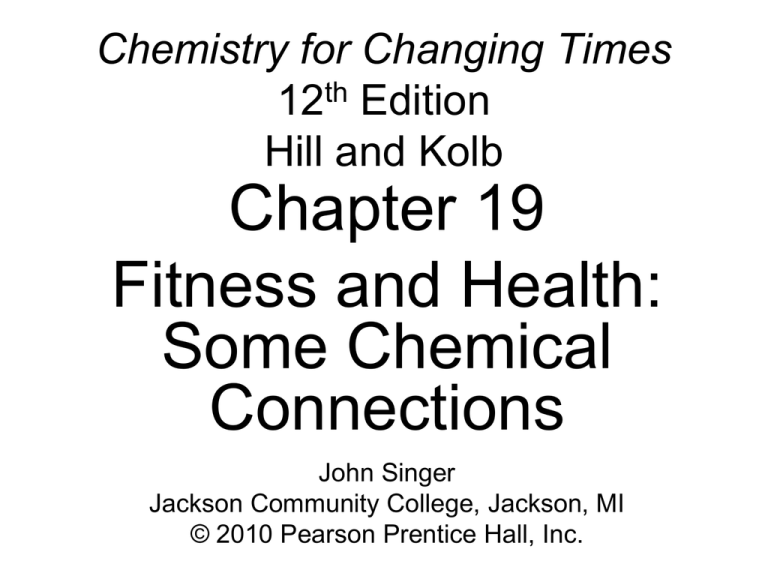
Chemistry for Changing Times
12th Edition
Hill and Kolb
Chapter 19
Fitness and Health:
Some Chemical
Connections
John Singer
Jackson Community College, Jackson, MI
© 2010 Pearson Prentice Hall, Inc.
Calories: Quantity and Quality
Caloric reduction may be the key to a long life.
Caloric reduction has been demonstrated to
promote longevity in mouse studies.
Humans seem to stay healthier when we eat
less than when we overeat.
© 2010 Pearson Prentice Hall,
Inc.
19/2
Calories: Quantity and Quality
Food Pyramid
© 2010 Pearson Prentice Hall,
Inc.
19/3
Calories: Quantity and Quality
Fat Intake
More than half of the fats in the American diet
are animal fats and 70% of saturated fat comes
from animal products.
It is recommended that total fat intake should be
between 20% and 35% of calories from fat. Most
should be polyunsaturated fat. Less than 10%
should be saturated fats and trans fats should be
minimized. Total cholesterol intake should be
less than 300 mg/day.
© 2010 Pearson Prentice Hall,
Inc.
19/4
Calories: Quantity and Quality
Dietary Reference Intake (DRI) are nutritionbased reference values established by the Food
and Nutrition Board of the U.S. National
Academy of Sciences for use in planning and
assessing diets.
© 2010 Pearson Prentice Hall,
Inc.
19/5
Calories: Quantity and Quality
Nutrition and the Athlete
Carbohydrates provide energy.
Muscle is built through exercise not by
consuming excess protein. As muscle contracts
against resistance, the amino acid creatine is
released. Creatine stimulates the production of
the protein myosin that contributes to the
construction of muscle tissue.
© 2010 Pearson Prentice Hall,
Inc.
19/6
Vitamins and Minerals
Vitamins are organic substances that the
human body needs, but cannot manufacture.
Minerals are inorganic elements required by the
body.
© 2010 Pearson Prentice Hall,
Inc.
19/7
Vitamins and Minerals
DRI Values of Vitamins and Minerals
© 2010 Pearson Prentice Hall,
Inc.
19/8
Vitamins and Minerals
Vitamin A is a fat-soluble vitamin that is
essential for vision, bone development, skin
maintenance, and may help resist cancers. Most
cruciferous vegetables, such as broccoli,
cauliflower, Brussels sprouts, and cabbage,
contain β-carotene, which is converted to
vitamin A by the body.
© 2010 Pearson Prentice Hall,
Inc.
19/9
Vitamins and Minerals
B vitamins are a class of eight water-soluble
vitamins important in maintaining the skin and
nervous system. B vitamins include:
• Vitamin B3 (niacin), which helps lower blood
cholesterol and provides relief from arthritis.
• Vitamin B6 (pyridoxine), which is a
coenzyme for more than 100 different
enzymes and has been found to be helpful in
relieving arthritis.
• Vitamin B12 (cyanocobalamin), prevents
pernicious anemia.
• Folic acid is critical to the nervous
development of a fetus and may help prevent
cardiovascular disease.
© 2010 Pearson Prentice Hall,
Inc.
19/10
Vitamins and Minerals
Vitamin C is known as ascorbic acid. It is a
water-soluble vitamin that serves a number of
functions. It will prevent scurvy, promote the
healing of wounds, burns, and lesions. It is
important in maintaining collagen and is an
antioxidant. In addition, it has been shown to
increase the body’s production of interferons,
which interfere with the growth of viruses.
© 2010 Pearson Prentice Hall,
Inc.
19/11
Vitamins and Minerals
Vitamin D is a steroid-type vitamin that
promotes absorption of calcium and phosphorus
and helps promote healthy bones and prevent
rickets.
© 2010 Pearson Prentice Hall,
Inc.
19/12
Vitamins and Minerals
Vitamin E is a mixture of tocopherols. Vitamin E
is an antioxidant that deactivates free radicals
and has been used to treat coronary heart
disease, angina, high blood pressure, varicose
veins, and other cardiovascular problems.
© 2010 Pearson Prentice Hall,
Inc.
19/13
Body Fluids and Electrolytes
Electrolytes are substances that form ions in
solution and allow the solution to conduct
electricity. In the human body, electrolytes are
required by cells to maintain charge balance and
control the flow of water molecules across the
cell membrane. The main electrolytes are Na+,
K+, Cl-, Ca2+, Mg2+, SO42-, HPO42-, and HCO3-.
© 2010 Pearson Prentice Hall,
Inc.
19/14
Body Fluids and Electrolytes
The best way to replace
water lost through sweat,
tears, respiration, and
perspiration is to drink
water.
© 2010 Pearson Prentice Hall,
Inc.
19/15
Body Fluids and Electrolytes
Effects of Dehydration
© 2010 Pearson Prentice Hall,
Inc.
19/16
Weight-Loss Diets
Dieting is a major industry in the U.S.
One pound of adipose tissue = 3,500 cal.
Reduction caloric intake by 100 cal/day would
cause the loss of one pound of fat in 35 days.
Very-low-calorie diets are likely to be deficient in
proper nutrition.
© 2010 Pearson Prentice Hall,
Inc.
19/17
Weight-Loss Diets
Biochemistry of Hunger
Ghrelin is an appetite stimulant peptide produced in the stomach.
Peptide YY (PYY) is an appetite suppressant peptide.
Leptin is a protein produced in fat cells. It promotes weight loss.
Most obese humans have high blood levels of leptin and are
resistant to its effects.
Cholecystokinin is a peptide produced in the intestine that
signals when we have had enough to eat.
© 2010 Pearson Prentice Hall,
Inc.
19/18
Weight-Loss Diets
Crash Diets: Quick = Quack
Quick weight-loss programs often involve water
loss to make the appearance of actual weight
loss. Many people who participate in such
programs will often regain their weight when the
body is rehydrated.
© 2010 Pearson Prentice Hall,
Inc.
19/19
Exercise for Weight Loss
Exercising increases the metabolic rate. This
leads to proper fitness and weight loss. The best
way to loose excess weight is to eat a nutritious,
low-calorie diet along with a consistent exercise
program.
© 2010 Pearson Prentice Hall,
Inc.
19/20
Measuring Fitness
Measuring fitness is
usually measuring the
amount of body fat.
Percentage of body fat
can be determined by
measuring a person’s
density, making
measurements of a
person’s waist and hips,
or by bioelectric
impedance analysis.
© 2010 Pearson Prentice Hall,
Inc.
19/21
Measuring Fitness
Body mass index (BMI) is used as a measure
of fatness:
BMI = 705 x body weight (lbs)
[height (in)]2
Ideal BMI for adults is between 18.5 and 24.9. A
BMI of 25-29.9 = overweight. Greater than 30 =
obesity.
© 2010 Pearson Prentice Hall,
Inc.
19/22
Measuring Fitness
VO2 Max: A Measure of Fitness
VO2 max is the maximum amount of oxygen, in
mL, that a person can use in one minute per
kilogram of body weight.
VO2 max can be estimated from the percent
maximum heart rate (%MHR) as follows:
%MHR = (0.64 x % VO2 max) + 37
© 2010 Pearson Prentice Hall,
Inc.
19/23
Some Chemistry of Muscles
The human body has about 600 muscles.
Exercise makes muscles larger, more flexible,
and more efficient in their use of oxygen.
With regular exercise, one’s blood pressure and
pulse remain lower and the person is able to do
more physical work with less strain. This is
known as the training effect.
© 2010 Pearson Prentice Hall,
Inc.
19/24
Some Chemistry of Muscles
Two proteins play an important
role in muscle contraction, actin
and myosin. Together, they
form a complex called
actomyosin. The potential
energy of adenosine
triphosphate (ATP) is
converted to kinetic energy of
muscle contraction.
© 2010 Pearson Prentice Hall,
Inc.
19/25
Some Chemistry of Muscles
Aerobic Exercise: Plenty of Oxygen
During exercise, ATP in muscle tissue is
consumed in a few minutes. The muscle tissue
then consumes glycogen and stores it for
energy. Under aerobic conditions, the glycogen
is converted to pyruvic acid and is oxidized to
carbon dioxide and water.
© 2010 Pearson Prentice Hall,
Inc.
19/26
Some Chemistry of Muscles
Anaerobic Exercise
and Oxygen Debt
Under anaerobic
conditions, the
pyruvic acid is
converted to lactic
acid. The build up of
lactic acid in muscle
tissue leads to muscle
fatigue.
© 2010 Pearson Prentice Hall,
Inc.
19/27
Some Chemistry of Muscles
Muscle Fibers
Type I (slow-twitch) fibers have high
myoglobin levels and therefore high respiratory
capacity. They are used for light or moderate
work and are active under aerobic conditions.
Type IIB (fast-twitch) fibers demonstrate a
high level of glycogen use and can generate
ATP rapidly. They are stronger and larger
muscle fibers that are more suited for anaerobic
activity.
© 2010 Pearson Prentice Hall,
Inc.
19/28
Some Chemistry of Muscles
© 2010 Pearson Prentice Hall,
Inc.
19/29
Some Chemistry of Muscles
Building Muscles
Endurance exercise
helps increase myoglobin
levels, but does not
contribute to muscle
mass. It favors the
development of Type I
muscle fibers.
© 2010 Pearson Prentice Hall,
Inc.
19/30
Some Chemistry of Muscles
Building Muscles
Weight training helps
build Type IIB muscle
fibers, but does not
increase respiratory
capacity.
© 2010 Pearson Prentice Hall,
Inc.
19/31
Drugs and the Athlete
Restorative drugs are used to alleviate pain, or
soreness, or treat injuries. These restorative
drugs include analgesics (painkillers), such as
aspirin and acetominophen, and antiinflammatory drugs, such as aspirin, ibuprofen,
ketoprofen, and cortisone.
© 2010 Pearson Prentice Hall,
Inc.
19/32
Drugs and the Athlete
Stimulant drugs are used to enhance
performance. These include caffeine,
amphetamines, and cocaine. Stimulants mask
symptoms of fatigue and give athletes a sense
of increased stamina.
© 2010 Pearson Prentice Hall,
Inc.
19/33
Drugs and the Athlete
Anabolic steroids include testosterone and its
semisynthetic derivatives. They are used to
increase muscle mass rapidly. Side effects of
taking anabolic steroids include testicular
atrophy, impotence, acne, and liver damage, as
well as potential cancer and growth of breasts.
© 2010 Pearson Prentice Hall,
Inc.
19/34
Drugs and the Athlete
The use of drugs to improve athletic
performance is unsafe and illegal. Many
competitions include drug screening to detect
the use of performance-enhancing drugs.
© 2010 Pearson Prentice Hall,
Inc.
19/35
Exercise and the Brain
Exercising causes the body to release painrelieving endorphins to the blood. These
endorphins are the cause of what is known as
the “runner’s high”.
Exercise also increases blood flow to the brain
and causes the production of neurotrophins,
which enhance the growth of brain cells.
Exercise is good for both the mind and body.
© 2010 Pearson Prentice Hall,
Inc.
19/36
No Smoking
Tobacco smoke contains more than 4,000
chemical substances. Tobacco use has been
linked to cancer, heart disease, emphysema,
and premature death. Smoking during
pregnancy can lead to stillbirth, premature birth,
and death of the newborn child. Exposure to
secondhand smoke causes an estimated 3,000
premature deaths each year in the U.S.
© 2010 Pearson Prentice Hall,
Inc.
19/37
No Smoking
© 2010 Pearson Prentice Hall,
Inc.
19/38






